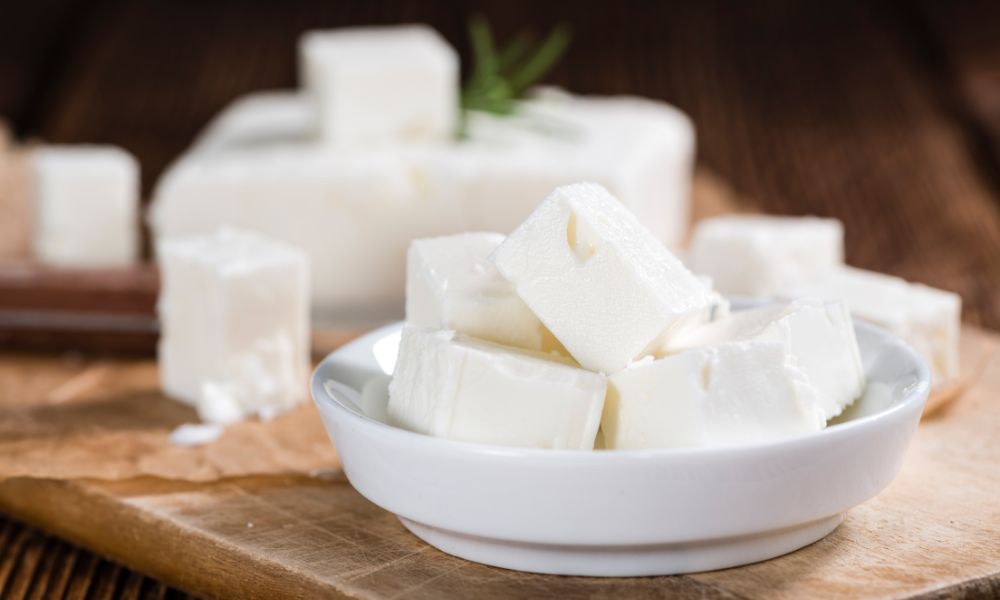It may depend on what you wish to do with the goat’s cheese, but overall feta will make a great substitute for goat’s cheese.
It’s not the only one, of course, so we will look at some other alternatives once we’ve looked at the differences between goat’s cheese and feta.
Does goat’s cheese taste like feta?
Feta is full of flavor and is cured in brine, which is a staple of cuisine in the Mediterranean diet.
It’s mostly enjoyed in salads or as part of a cheese platter.
Though it does make a great alternative to goat’s cheese, there are some important differences.
Feta cheese is traditionally made with 100% sheep’s milk.
In some cases, it can contain as much as 30% goat’s milk, but in general it does not.
Goat’s cheese, on the other hand, as you might have guessed, is made entirely from goat’s milk.
European law dictates that anything calling itself feta cheese has to contain at least 70% sheep’s milk, but these rules do not apply outside of Europe.
In the US, feta could be made from cow’s milk; check the label to be sure.
Part of the reason feta tastes so close to goat’s cheese is that sheep are more similar to goats than cows are.
Both feta and goat’s cheese are usually white, creamy cheeses.
Feta has a much nuttier smell and a tangier, saltier taste.
This is due to the curing in brine which it undergoes.
Goat’s cheese has an earthier aroma, with a tart, bold flavor.
Goat’s cheese may have a rind or skin of some kind, whereas feta is shaped into blocks during production.
So, they are very similar in many ways, and though naturally a discerning cheesemonger could quickly tell the difference, they are often mistaken for one another by lay people.
The taste is very similar.
But, what about nutritionally?
| Related Article |
|---|
How do goat’s cheese and feta cheese compare nutritionally?
Cheese is a great source of nutrients like protein and calcium.
Some cheeses also contain high quantities of healthy, fatty acids, such as conjugated linoleic acid, or CLA.
Research suggests that this group of fats helps prevent heart disease and reduces body fat.
Both feta cheese and goat’s cheese often contain CLA.
The final amount in the product when it hits the shelves will be dependent on production methods, like how long they’re aged and ripened.
This can affect how much is retained in the final product. But both usually contain some.
Both will also support bone health through the high amounts of calcium and protein.
Feta is a great source of many nutrients and minerals which have been shown to promote bone health.
Feta does, unfortunately, contain higher quantities of sodium than goat’s cheese.
Lots of salt is involved in the process of making feta cheese since it is cured in brine and salt is added to the curd.
The brine they are submerged in is up to 7% salt.
Unripened cheeses tend to be higher in lactose than aged cheeses, which can present problems for those who struggle to digest cheese.
Finally, unpasteurized dairy products can cause a lot of issues for pregnant women, so it’s better to avoid soft cheeses like goat’s cheese and feta cheese while pregnant.
What is a good substitute for goat’s cheese in a recipe?
So, we’ve covered goat’s cheese, but what else would make a good substitute for goat’s cheese in a recipe?
Again, it will depend on what you’re using it for, but almost any soft cheese is likely to make a good alternative.
Cream cheese has a similar texture, but it doesn’t quite pack the same tang.
Recipes such as creamy pasta sauces where you would normally use goat’s cheese will do great with cream cheese.
Feta is best used in salads, as you get that essential crumble.
Try a French lentil salad or a beet salad and include feta for a great goat’s cheese alternative.
Finally, for spreading cheeses, labneh and ricotta are your best options.
Taste-wise, you are straying a little far from goat’s cheese here, but you will get that spreading that you would get from a goat’s cheese spread.
Labneh is Mediterranean yogurt cheese, and has a similar thick texture and tangy taste.
So, feta will make a great substitute for goat’s cheese in tons of dishes.
It has the perfect, crumbly texture which will go great in salads, and the right cheese will pack the same tangy taste.
Goat’s cheese, I’ve found, isn’t always as easy to get as feta cheese, but don’t worry—they both make great substitutes for one another.

